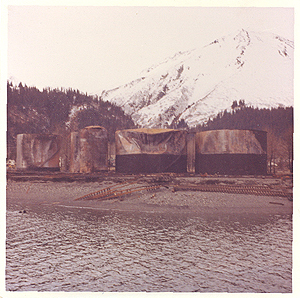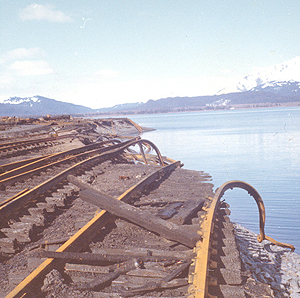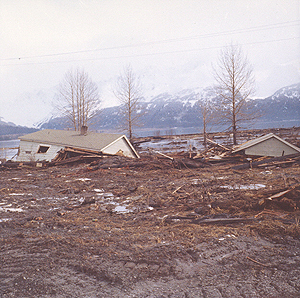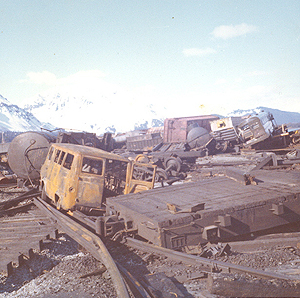Seward devastated during 1964 earthquake
Seward devastated during 1964 earthquake
Submitted by Ned Rozell
Phone: 474 7468
04/10/09

Download image

Download image

Download image

Download image
Tammy Wisdom of Baker City, Oregon, wrote and asked if any Alaska Science Forum readers knew of her grandfather, Alva "Al" Wisdom. Al Wisdom died in Seward in 1964 as a result of a wave generated by the Good Friday Earthquake. This request inspired some readers to share their own stories of Seward during and following the earthquake.
Larry Werner of Anchorage, 61, was a junior in high school when the earthquake struck Alaska on March 27, 1964. He remembers trying to flee Seward with his mother in her car because "everything was on fire."
Werner and his mother drove down Third Avenue, then the only way out of town, to find that a wave had deposited railroad cars, parts of houses, and other debris on the road. Werner said he saw Al Wisdom on a bulldozer, trying to clear the road.
"I ran over and talked to Al on the Cat," Werner said. "He said, ’Check back in a little while, it’s going to take a while to clear through this mess.’"
Werner and his mother then drove to their home, on higher ground, and that move probably saved their lives. Perhaps 20 minutes later, a tsunami created by the earthquake swept over Seward again.
Waves from a variety of sources"¹the underwater landslide beneath Seward’s waterfront, the sloshing effects in Resurrection Bay, and from the displacement of water from the earthquake fracture on the floor of Prince William Sound, devastated Seward, wrote Richard Lemke, who visited the town right after the earthquake and wrote a report for the U.S. Geological Survey. Lemke wrote that people saw the first of the waves right after the earthquake, at 5:36 p.m., and the waves "continued to arrive fairly regularly . . . until at least 11:30 p.m."
Monty and Florita Richardson moved to Seward in 1957. They were there on March 27, 1964, and still live there today. Like most Seward residents, they were trying to escape the fires caused when the first waves hit.
"To get away from the fires, we got down on the beach," Monty, 91, said. "None of us were really thinking of tsunamis, the whole lower end of town was blazing."
Burning oil covered most of the water surface and parts of houses and docks the early waves destroyed. It could have been worse, Lemke wrote.
"Had not a gentle wind been blowing eastward across the bay, the entire town probably would have burned."
Preoccupied with the fires, Richardson also noticed something else.
"We saw that the water went way out beyond what any of us could remember having seen it before. That should have told us something."
Richardson recalled looking out at the water and seeing what looked like "a snowslide coming down the mountain, but it was a (tsunami) coming down the bay. We saw it and heard it coming and got away from it."
Wyman Owens was 29-years-old and working as a longshoreman in Seward on March 27, 1964. Owens was living in a hotel in Seward when he felt the ground shake.
"The minute it hit, there wasn¹t any messing around," said Owens, now 74 and living in Anchorage. "It was just, ’bang!’ I watched the TV set in the lobby come off its stand. People were screaming outside and it was shaking so hard I thought the mountains were going to come down."
Owens looked down the street and saw several giant fuel tanks collapse and burst into flames. He jumped into a truck with a co-worker and remembers looking out toward the bay and seeing a large wave.
"There was a big, black, immense wall of water coming in," he said.
His co-worker dropped him off at his house so Owens could drive his coworker’s car to higher ground. Owens remembers his hands shaking so much that he had to use both of them to fit the key in the ignition.
Owens then remembers driving to high ground and seeing a "really, really, horrendously big" wave engulf Seward.
Next week: More on Tammy Wisdom’s grandfather.


